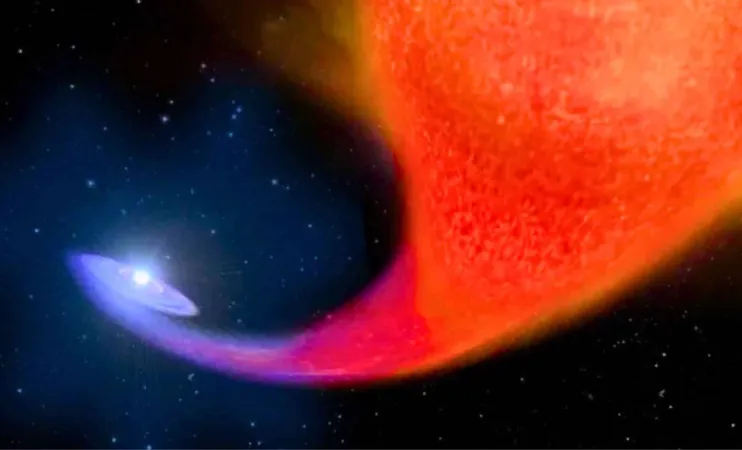
Hubble Unveils Fascinating New Star: The 'Blue Lurker' in the Milky Way That Defies Stellar Evolution!
2025-01-23
Author: Wai
Hubble Unveils Fascinating New Star: The 'Blue Lurker' in the Milky Way That Defies Stellar Evolution!
In what may come as a surprise to many, the cosmos is still brimming with secrets, even in 2025. The Hubble Space Telescope, a titan of astronomical exploration, has discovered an astonishing new class of stars known as "blue lurkers," challenging our understanding of stellar evolution and the intricate dynamics of star systems.
A Journey Through History: The Birth of Blue Stragglers
To contextualize this groundbreaking discovery, let's revisit celestial history. Back in 1953, renowned American astronomer Alan Sandage made a remarkable breakthrough within the globular cluster M3 (NGC 5272), pointing out the existence of blue stragglers amidst a sea of ancient stars. M3, discovered in 1764 by French astronomer Charles Messier, is located roughly 33,300 light-years away in the constellation Canes Venatici. This crowded stellar cluster is home to approximately half a million stars, predominantly ancient and red.
Sandage's blue straggler was a young, blue star that raised serious questions: how could such a vibrant entity arise in a cluster estimated to be over 8 billion years old? The enigma was unraveled through processes like stellar collisions and mass transfers in binary systems, phenomena that proliferate in the densely packed environment of globular clusters.
Unraveling the Blue Straggler Mystery
Blue stragglers emerge mainly through two mechanisms:
1. **Stellar Collisions:** In the dense regions of globular clusters, stars can collide and merge, resulting in a more massive and hotter star — a phenomenon that causes the new star to appear significantly bluer.
2. **Mass Transfer in Binary Systems:** In binary star systems, one star can siphon mass from its companion, effectively rejuvenating the latter and boosting its luminosity.
Enter the Blue Lurkers: A New Stellar Paradox
Hubble's recent discovery stretches the boundaries of our stellar knowledge even further with the introduction of blue lurkers. Observed in the open cluster M67, these stars share some characteristics with blue stragglers, yet present a unique conundrum. One particularly intriguing blue lurker is a yellow star, comparable in mass to our Sun, but spinning at an astonishing speed.
The Technical Marvel of the Blue Lurker
- **Astounding Rotational Velocity:** Unlike typical Sun-like stars, which complete a rotation in about 30 days, this blue lurker spins every four days, signaling a tumultuous past.
- **Intriguing Ultraviolet Spectroscopy:** Hubble's observations also revealed that this blue lurker orbits a white dwarf with a remarkable surface temperature nearing 17,000 K, significantly hotter than our Sun.
- **Complex Triple System:** This blue lurker is part of a triple system, where the more massive white dwarf likely formed from the merger of two stars approximately 500 million years ago. This merger would have imparted mass and angular momentum to the blue lurker, explaining its rapid rotation.
Emily Leiner from the Illinois Institute of Technology marvels at the star's complex history, stating, “This star has had a super complicated evolutionary history. It’s really exciting because it’s an example of a star that has interacted in a triple-star system.
The Broader Implications of Blue Lurkers
The intriguing behavior of blue lurkers provides invaluable insights into the evolution of triple star systems, which are still poorly understood yet make up about 10% of Sun-like stars. The white dwarf linked to the blue lurker, being more massive than typically expected, hints at a stellar merger's past, further making the case for complex interactions within these systems.
- **Modeling Stellar Evolution:** The blue lurker phenomenon poses a unique opportunity for astronomers to refine models of star evolution, especially in multi-star systems where various interactions occur.
- **Reevaluating Open Cluster Dynamics:** The presence of blue lurkers in clusters like M67 suggests that open clusters can also host significant stellar interactions, reshaping our interpretation of their evolution and dynamics.
“The universe remains a treasure trove of mysteries, and the discovery of blue lurkers highlights that there is so much we still don’t understand,” Leiner adds.
As we continue to probe the cosmos with instruments such as Hubble, the secrets of the universe unfold before us. Whether they are blue stragglers or blue lurkers, these alluring stars invite us to delve deeper into the marvels of stellar evolution. The universe proves endlessly fascinating, consistently inspiring astronomers and stargazers alike to explore its vastness. Stay tuned as we uncover more celestial wonders!




 Brasil (PT)
Brasil (PT)
 Canada (EN)
Canada (EN)
 Chile (ES)
Chile (ES)
 Česko (CS)
Česko (CS)
 대한민국 (KO)
대한민국 (KO)
 España (ES)
España (ES)
 France (FR)
France (FR)
 Hong Kong (EN)
Hong Kong (EN)
 Italia (IT)
Italia (IT)
 日本 (JA)
日本 (JA)
 Magyarország (HU)
Magyarország (HU)
 Norge (NO)
Norge (NO)
 Polska (PL)
Polska (PL)
 Schweiz (DE)
Schweiz (DE)
 Singapore (EN)
Singapore (EN)
 Sverige (SV)
Sverige (SV)
 Suomi (FI)
Suomi (FI)
 Türkiye (TR)
Türkiye (TR)
 الإمارات العربية المتحدة (AR)
الإمارات العربية المتحدة (AR)